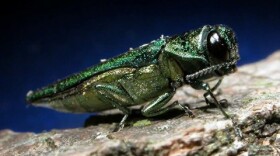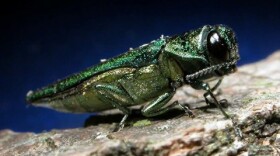The Emerald Ash Borer (EAB) has continued to spread through the tri states region. Most recently the destructive insect has been found in McDonough County.
Chris Enroth, a Horticulture Educator at the University of Illinois Extension, said the EAB attacks healthy ash trees from the top. He said ash trees are tough and resilient and will try to fight back by forming water sprouts.
“It’s a lot of this twiggy, upright growth in the tree. That’s the tree trying to overcome the feeding pressure from these beetles. Unfortunately, though, it just won’t and you’ll slowly start to see that damage moving from the top of the canopy down to the soil line,” Enroth said.
He said other signs of EAB infestation include cracking in the tree’s trunk and damage from woodpeckers, which feed on the EAB larvae.
Enroth said homeowners basically have two options:
- Treat your ash trees with a systemic insecticide
- Cut down your ash trees
Enroth noted that an ash tree with more than a 15-inch diameter must be treated by a licensed applicator. And he warned that people must remove dead or damaged ash trees because they pose a danger.
“Once that tree is dead, it actually starts to degrade fairly quickly when it’s out in the natural environment,” Enroth said. “You have about two years before that tree essentially would probably fall down. That’s why we recommend to homeowners that if you’re not treating and you do have a substantial amount of dead canopy in your ash tree, you really do need to have it removed.”
Enroth said there is no cure for an EAB infestation. Treatments simply delay the inevitable so the future is bleak for the ash trees.
“We kind of have our fingers crossed,” Enroth said. “Somewhere here in the Midwest or North America there’s going to be maybe a few lone ash trees standing that maybe are a bit more resistant to that. You know, you just got to sit tight, cut down your tree or treat them, and that’s about all we can do right now.”
EABs are originally from Asia. The insects were first found in the United States in the early 2000s in Michigan. Enroth said the primary travel method for the beetle is people transporting wood. He said without humans, EAB would only move a half mile a year.
Ash tree owners can contact Enroth at the University of Illinois Extension for more information regarding the threat.







